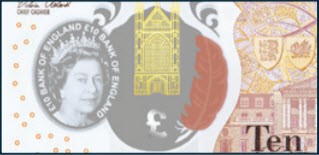Preparing for the redesigned currency
Beginning in 2013, the Bank of England (BoE) began the difficult process of updating the nation’s currency in an effort to discourage counterfeiters. The operation involved a comprehensive redesign of the £1 coin along with the £5, £10 and £20 banknotes, which included altering the appearance, shape and materials of the currency.
While these may seem like insignificant changes, they will have a noticeable effect on your business. For that reason, you should review the provided guidance, which briefly explains these changes, how your business could be impacted and what you can do to prepare.
Changes to the £1 Coin
The changes to the £1 coin are as follows:
- 12-sided: The new distinctive shape is meant to help the coin stand out by both sight and touch.
- Bimetallic: The outer ring of the coin is gold coloured and the inner ring is silver coloured.
- Latent image: The coin has an image similar to a hologram that changes the ‘£’ symbol to the number 1 when the coin is viewed from different angles.
- Micro-lettering: There is tiny lettering around the rim of the heads side of the coin that reads, ‘ONE POUND’. On the tails side, the year that the coin was produced is lettered around the rim.
- Milled edges: The coin has grooves on alternate sides.
- Hidden high-security feature: The BoE has built an additional security feature into the coin to protect it from counterfeiting. However, details about this feature have not been revealed in order to ensure that counterfeiters are unable to replicate it.
Changes to the £5, £10 and £20 Banknotes
The changes to the £5, £10 and £20 banknotes are as follows:
- Polymer: The redesigned banknotes will be printed on polymer, a thin and flexible plastic material in order to make them cleaner, safer, stronger and more environmentally friendly than paper notes.
- Size: The redesigned banknotes will be about 15 per cent smaller than the current paper notes.
- See-through window: A clearly defined portrait of the Queen is printed on a large see-through window on the left side of the note. The value of the note along with ‘Bank of England’ is printed along the edge of the window.
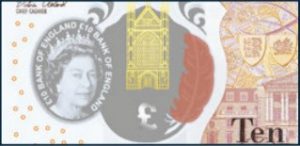
- Metallic images: The Elizabeth Tower is positioned over the see-through window on the £5 note, and Winchester Cathedral is positioned over the see-through window on the £10 note, both of which are gold on the front and silver on the back. The see-through window image for the £20 note is forthcoming. When the £5 note is tilted, the see-through window’s coloured border and its ‘£’ sign changes from purple to green. When the £10 note is tilted, a coloured quill to the side of the see-through window changes from purple to orange.
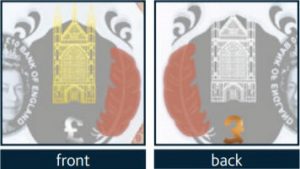
- Foil patches: There are two silver foil patches on the front of the redesigned banknotes. The first is above the see-through window and contains an image of the coronation crown. The crown appears to be 3D and, when the note is tilted, a multi-coloured rainbow effect occurs.
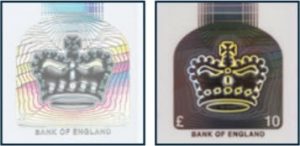
The second patch is below the see-through window and displays the words ‘five’ or ‘ten’. When the note is tilted, the number changes to the word ‘Pounds’ and a multi-coloured rainbow effect occurs.
- Micro-lettering: Beneath the Queen’s portrait, the value of the note is written in small letters and numbers.
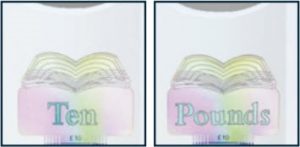
- Ultraviolet (UV) numbering: On the front of the redesigned banknote—just to the left of the Queen’s portrait—the number 5 or 10 appears under UV light.
- New historic characters: While the redesigned banknotes will still feature a portrait of the Queen on the front, the historical figures on the back are changing. The new historic figures include the following:
- Sir Winston Churchill on the £5 note
- Jane Austen on the £10 note
- M.W. Turner on the £20 note
The Timeline for the Redesigned Currency
Here is a comprehensive timeline of events concerning the design and implementation of the redesigned currency along with deadlines for businesses to accommodate them.
2016
- Businesses are able to start adapting machines for the polymer banknotes.
- The new £5 note was issued on 13 September.
2017
- On 28 March, the BoE issued the redesigned £1 coin. Businesses may accept both the old and new coins until 15 October. After that, businesses are under no obligation to accept the old £1 coin and should not distribute it.
- On 5 May, the BoE withdrew the paper £5 notes.
- On 6 May, businesses were no longer required to accept paper £5 notes and are encouraged to not dispense paper notes in an effort to remove them from circulation.
- On 14 September, the new £10 note went into circulation.
- On 15 October, businesses are no longer required to accept the old £1 coins and are encouraged to not dispense them in an effort to remove them from circulation.
2018
- By spring 2018, the old £10 note goes out of circulation.
By 2020
- The new £20 note will be issued.
How to Prepare for the Redesigned Currency
As the BoE continues to introduce the redesigned currency into the market, your business must be proactive in its efforts to adapt and prepare. If you do not, you leave yourself exposed to two main risks:
- The redesigned currency would not be recognised by your cash-handling machines, which includes self-service checkouts, ticket machines and any other machine that weighs, counts, sorts, accepts, dispenses or recycles currency.
- It’s likely that your employees will not be able to be able to identify and authenticate the redesigned currency, leaving your business exposed to counterfeiters.
To mitigate these risks, consider implementing the following best practices:
- Provide all of your employees that handle money with training on how to properly identify and authenticate the redesigned currency. In addition, all new hires should also receive this training if they handle money.
- Purchase high-quality UV lamps that emit light at around 365 nanometres in order to test the redesigned banknotes for authenticity.
- Adapt your cash-handling machines to effectively recognise and handle the new coins and polymer banknotes. To find out what adjustments need to be made to the machines, contact the manufacturer or supplier. In most instances, the machines will need a software update.
- If you purchase a new cash-handling machine in the future, be sure to ask whether the machine is already calibrated for the redesigned currency. A list of cash-handling manufacturers that have tested new notes and their machines’ ability to accept them can be found by clicking here. If your manufacturer is not listed, let the BoE know by emailing them at enquiries@bankofengland.co.uk.
- Calibrate your weighing scales in order to accurately weigh the lighter polymer banknotes. To find out what specifications you will need to adjust your scale to, contact the machine manufacturer or supplier.
- Adapt the cash machines at your business that are filled with takings from the till to dispense the new polymer banknotes. Your cash machine supplier will contact you to schedule the maintenance for the machines. Alternatively, if your business hosts a cash machine that is filled by a cash-in-transit company, you do not need to do anything. The cash machine operator and cash-in-transit company will be responsible for those machines’ maintenance.
- Adapt your business’ self-service tills to accept payment from the redesigned currency. To do so, contact the machine manufacturer or supplier. In general, the machine will need a software update and the dispense cassette will need to be adjusted for the new banknote size.
- Access educational materials from the BoE to help employees identify genuine banknotes by clicking here.
Make Changes with Confidence
The redesigned currency should block counterfeiters’ efforts to produce fraudulent banknotes and coins. However, while the transition should not be invasive or disruptive, it could nevertheless negatively affect your business. For that reason, you should prepare by training your staff and renovating any cash-handling machines.
For all other enquires about how you can bolster and protect your business, contact Lockyers today on 01924 278222.

